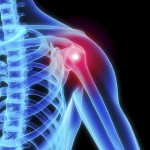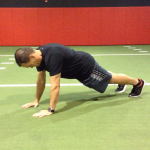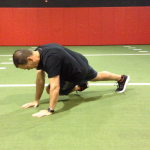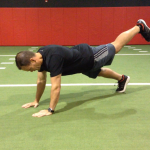Brian Schiff’s Blog
Injury Prevention, Sports Rehab & Performance Training Expert
It is that time of year where baseball pre-season throwing is ramping up. I am starting to see throwers coming in to my clinic with shoulder and elbow issues. In many cases, injury can be avoided with proper stretching and strengthening as well as effective loading programs.
Pectoralis major/minor and latissimus muscle tightness along with poor scapular control often leads to postural dysfunction and shoulder problems. Improving shoulder mobility and scapular control can reduce injury risk and shoulder strain.
The video below from one of my Functional Fit columns will demonstrate an excellent exercise that can be programmed for every thrower to aid in optimizing shoulder mobility and promoting shoulder health.
I often use this exercise following soft tissue release techniques and in conjunction with thoracic spine extension mobilization on the roller. It is an excellent warm-up and activation exercise.
Many athletes and clients I work with lack adequate pillar and shoulder stability. Whether this is related to acquired laxity, inherent instability or simply a lack of proper muscular control, I think it is important to assess baseline stability in anyone performing overhead lifts, ballistic upper body training and in overhead athletes.
In my clinic, I work with lots of baseball players, swimmers and volleyball players. Most females tend to struggle with hyper mobility (loose shoulder joints) whereas many of my males tend to have soft tissue tightness and in some cases limited internal rotation (GIRD). Both males and females tend to have a need to improve dynamic shoulder and pillar (core) stability to reduce injury risk and optimize mechanics.
The following exercise is one I use to both assess anti-rotational control/stability as well as train the body to resist torsional forces. In the video below, you can see how to assess your baseline strength and stability.
This exercise is very effective in working improving glenohumeral and scapular stability as well as enhancing shoulder, torso and hip stability. In my opinion, athletes with poor stability in this assessment should not perform unilateral Olympic lifting or ballistic overhead training as they may lack the necessary neuromuscular control to execute the proper movement pattern.
Many of my clients need to improve shoulder and pillar stability. Combating poor glenohumeral and scapular stability and insufficient trunk stability is a must to reduce injury risk, resolve shoulder and back pain and eliminate compensatory motion with exercise, sport and life.
The following two exercises are “go to” ones I utilize to do just this.
The links above are for two recent exercise columns I authored for PFP Magazine. These exercises include load bearing using the client’s bodyweight and include progressions and regressions.
Increasing shoulder, torso and hip strength and stability is a common training goal for athletes involved in sport. Facilitating hip disassociation and kinetic chain linking with exercise is always a plus. I like to use a diagonal mountain climber with hip extension to accomplish these objectives. More specifically, I utilize this exercise with my overhead athletes and anyone involved in cutting, pivoting and rotational sports.
Begin in a tall plank position. The hands should be beneath the shoulders with the feet on the floor and shoulder width apart. Slowly bring the left knee/hip under the body and toward the right elbow. Pause at the end point prior to losing form or control.
Next, return the left leg toward the start position and up into full hip extension in one continuous movement. Pause at the top end of available hip extension and repeat the cycle for 10 repetitions or time on the same leg. Alternate legs and perform 2-3 sets on each side.
Sufficient upper body strength and core/hip stability in a 3 point position is necessary to perform the exercise correctly. At no time should the foot of the moving leg touch the floor or be used to balance the body. As far as a pace, I feel using a 1/1/1/1 cadence works best.
This exercise is an excellent way to promote shoulder, core and hip stability while facilitating hip disassociation as well. Driving the hip back up into extension will activate the gluteals and simultaneously force the stable (fixed) hip to stabilize the pelvis and counterbalance the movement pattern. In addition, the client will have to effectively activate the hip and abdominal musculature throughout to avoid unwanted pelvic tilt/rotation during the movement.
Click here to view the full video of this exercise I did for my ‘Functionally Fit’ column for PFP Magazine.
In the past, I wrote a post about Crossfit and shoulder pain based on a 38 y/o male client of mine. Click here to read that post. In my prior entry, I discussed differential diagnosis of rotator cuff and labral pathology, as well as my treatment approach for that client.
If you follow my blog, twitter feed or webinars, you know I treat a lot of Crossfit athletes. Recently, I worked with a 25 y/o female suffering from marked shoulder pain that was keeping her out of the gym.
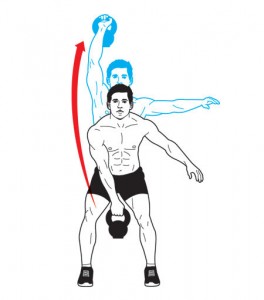
Below are the key findings from her intake on 8/30/13:
- Onset of left shoulder pain on 8/8 related to snatches
- Right hand dominant
- Intermittent pain if sleeping on her left side
- Full AROM
- Mild weakness with supraspinatus and external rotation on left
- Positive impingement signs
- Positive O’Brien’s test (labral test)
- Positive sulcus sign bilaterally (indicates multi-directional instability or MDI)
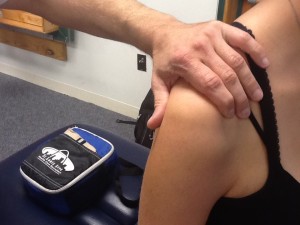
Sulcus sign
Treatment intervention
- Rhythmic stabilization and PNF exercises
- Rotator cuff and scapular strengthening
- Closed chain stabilization training
- Game Ready (cryotherapy)
- Home program issued at visit #1
I saw the patient once per week and she did her home program for 4 weeks. At week 4, we gradually began allowing her to do some modified gym workouts but still no snatches or full overhead work. She was pain free at this time and all impingement/labral signs had resolved. At this point she returned to some wall ball drills (limited height) but still no snatches.
The client’s final visit was on 10/2/13. Her Quick Dash percentage of perceived shoulder dysfunction was now 0%. She was symptom free, but more importantly she had a great understanding of how to modify her lifts, loads and volume based on her multi-directional instability. She was now aware of how her instability impacts her shoulder in “at risk” positions and in the face of fatigue. This brings me to the primary reason for this second post related to Crossfit and shoulder pain.
In my initial post, I focused on overuse and shoulder inflammation as a result of poor mobility, muscle imbalances and a lack of physical preparedness to do high intensity exercise like Crossfit. On the other end of the spectrum lies the unstable shoulder.
Hypermobility and/or shoulder instability is a major problem for those doing Crossfit in light of the following:
- Many lifts and exercises put the shoulder in “at risk” positions
- Poor glenohumeral joint stability places more stress on the rotator cuff and long head of the biceps
- With the AMRAP approach and train to failure nature of the WOD, fatigue is a given and this means the stabilizing muscles that matter most will often fail leading to a much higher injury risk
Key Takeaways
- My client had secondary rotator cuff and bicipital irritation related to primary instability
- Rest and a combined stabilization and cuff/scapular strengthening exercise program was effective in resolving her symptoms within 30 days
- High load/high volume overhead lifts and those that place the shoulder at end range pose a higher injury risk for those with MDI or anterior instability
- Shoulder stability work trumps mobility work in those with shoulder instability – this often runs counter to traditional approaches that tend emphasize better mobility (one program does not fit all)
Closing thoughts
We must keep in mind that the shoulder is inherently unstable in order to allow us the freedom of movement necessary to perform the various tasks and exercise. With that said, repetitive movements and lifts can create micro and/or frank shoulder instability over time. Those with a history of shoulder subluxation/dislocation/instability are a high risk group to begin with. Adding high loads to failure places the shoulder in a fatigue and compromising state. As a coach, competitor or health professional, we must remember that even the best intentions and coaching can fail us if the risk of a lift outweighs the reward.
As I have said before, anyone who decides to do Crossfit MUST get a proper assessment prior to starting to reduce injury risk. Ideally, this assessment would begin with a full FMS to help uncover any mobility or stability issues and asymmetry. Keep in mind research reveals that females will almost always score a 3 on shoulder mobility and many may be hypermobile. Conversely, they tend to score lower (1 in many cases) on the trunk stability push-up. Any pain with screening would necessitate a referral to a PT or MD for further evaluation.
Trainers cannot be asked or expected to catch multi-directional shoulder instability. However, they can and should be aware of relative risk, anatomical tendencies and red flags that may predispose clients to injury. For those wanting to be the best in the business, I would suggest developing a system for assessing clients and partnering with allied health professionals like me to incorporate best practices in their business. Perhaps most importantly, trainers and coaches must be willing to adapt, limit, or eliminate exercise that does not fit the needs and abilities of the clientele.
The random nature of the WOD makes it difficult for unassuming clients to judge how best to fit in the Crossfit model if they have a dysfunction or injury concern. My goal is always to empower people with knowledge about their body and sound advice for optimal training. For those intent upon getting back to Crossfit after injury, I work hard to normalize their function and offer tweaks and modifications to prevent re-injury. Prehab is a must for this population. But in the end, some shoulders will simply not be able to handle the rigors and intensity of Crossfit.


